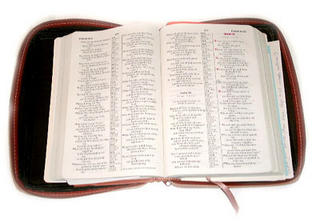Confirmation
is a sacrament in which, through the laying on of the bishop’s
hands, prayer, and anointing, those who have been baptized are
strengthened by the Holy Ghost so that they may firmly profess their
faith and sincerely live up to it.
How
does the bishop administer Confirmation?
-
He extends his hands over those to be confirmed, and prays the Holy Ghost to descend upon them with His sevenfold gifts.
-
He then lays his hand upon each one, and anoints him with holy chrism.
-
He gives him a slight blow on the cheek, saying, “Peace be with you.”
-
He concludes by giving them all the episcopal benediction.
What
does the imposition of hands signify?
It signifies the descent of the Holy Spirit, and particularly the protection of God under which the Christian is henceforth to remain.
How
does the bishop anoint those to be confirmed?
He makes the sign of the cross with chrism on the forehead of each one, saying at the same time: “I sign thee with the sign of the cross, and I confirm thee with the chrism of salvation, in the name of the Father, and of the Son, and of the Holy Ghost. Amen.”
Of
what does the chrism consist?
The chrism, which every year on Holy Thursday is blessed by the bishop with great solemnity, consists of the oil of olives and balsam.
What
does the oil signify?
The oil signifies inward strength for the struggle against the enemies of our salvation. Oil was formerly used by soldiers and athletes to make their limbs supple and strong. As oil strengthens the limbs of the body, so does the Holy Spirit strengthen our souls for combat with sin.
Why
is fragrant balsam mixed with the oil?
To signify that he who is confirmed receives grace to keep himself pure from the corruption of the world, and by a pious life give forth the sweet odor of virtue. Balsam serves to preserve wounds from corruption, and gives forth a pleasing and fragrant odor.
Why
does the bishop make the sign of the cross upon the forehead of the
one to be confirmed?
To signify that a Christian should never be ashamed of the cross, but confess without fear his faith in Christ crucified. “For I am not ashamed of the Gospel. For it is the power of God unto salvation for everyone that believeth.” (Romans 1:16)
Why
does the bishop after anointing him give him a slight blow on the
cheek?
To remind him that, as he is now strong and accountable, he should be ready to suffer patiently any humiliation for Jesus’ sake.
Why
does he at the same time say, “Peace be with you”?
Because, having now received the fullness of divine grace and heavenly peace, he should carefully guard it as a consolation in every sorrow.
A
priest thereupon dries with a piece of cotton the brow of the person
being confirmed, in order to prevent the sacred chrism from being
desecrated in any way.
What
are the words of the benediction given by the bishop after
Confirmation?
May the Lord bless you out of Sion, that you may see the goods of Jerusalem all the days of your life, and have life everlasting. Amen.
Why
are sponsors also ordained for Confirmation?
That they may first see that the person is confirmed, and then by deed and word aid him in the spiritual combat to which by this sacrament he has been dedicated.
The sponsor binds himself to the fulfilment of this duty by laying his hand. on the right shoulder of the person being confirmed. He thus becomes his spiritual parent and guardian for the preservation of the grace of Confirmation. The same spiritual relationship and impediments of marriage exist as with sponsors in Baptism.
What
does the Church require of sponsors in Confirmation?
They must be Catholics; they must be confirmed and old enough to be able to fulfil their duties as sponsore. Parents cannot be sponsors for their children; nor can the same person be sponsor both at Baptism and Confirmation.
– Goffine’s
Devout Instructions






